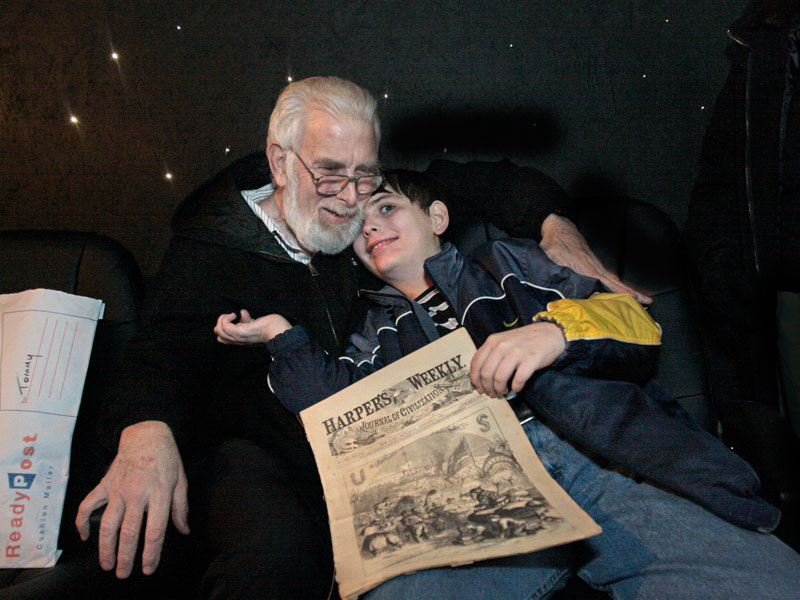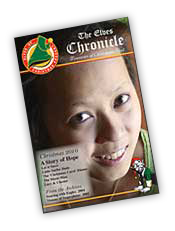The mission began inside a black limousine. Leather seats, high-tech lighting, a Bose speaker system.
Below a shelf of glass goblets — “Is that a bar?”— Kathy Harris discovered a lift-off compartment with iced-down soft drinks, including Dr. Pepper, her sonʼs favorite.
“Tommy, do you want some?ʼ she asked her 13-year-old.
He nodded, almost laughing. His dad, Howard Harris, just grinned. A delivery truck driver, heʼd been trying to see where this limo was taking them, but heʼd lost track. Until, with just the barest hint of bumpiness, “Are we on a gravel road?”
Tommyʼs parents were feeling something they hadnʼt felt for a while, not since Tommyʼs cancer diagnosis and a year of chemotherapy, including a hard six months of trying to find the right cocktail of anti- nausea medications.
On this Christmas Eve night, their faces reflected only joy. Just minutes into what would become a three-hour adventure, Tommy already felt like he was living a magical night. His parents did, too.
Tommy was on a mission for a special friend — to deliver an antique toy back in time, through a delivery system unimagined even by Federal Express or UPS. The collective genius of hundreds of elves who call themselves The Elves of Christmas Present brought it all together through their most elaborate Christmas gift in their more than 20 years of making Christmas memories.
Tommyʼs adventure was just unfolding. But the story really begins hours earlier, when Christmas Eveʼs most popular man knocked on the Harrisesʼ Raytown door.
Santaʼs request
“Good afternoon! May I come in for a visit?”
Tommyʼs 11-year-old sister, Ariel, couldnʼt speak. Santa Claus stood at her familyʼs front door. Santa Claus! After letting him in, she ran outside looking for the reindeer.
His chortles (and yes, all those ho-ho- hos) brought out three more curious children, five in all. Tommy ran to him and hugged him hard without saying a word.
“Tommyʼs a hugger,” Kathy Harris said, a little chagrined.
The tall Santa carried a 7-foot wooden staff. Probably the worldʼs best authority on children, he knew to sit down, make himself look smaller and invite them to come to him.
He read from his book of good children. He knew their birthdays, their best friends, their good deeds, their Christmas wishes, their struggles. And he had one special request: Could Tommy give him a present?
“It isnʼt very often that I get something I want for Christmas,” Santa said.
He waited, looking deep into Tommyʼs eyes.
The boy smiled.
Santa explained that his great, great, great, great grandfather, the first Santa Claus in the United States, had left a message asking if someone in the future could right a mistake.
“What is it, Santa?” Tommy asked.
Go back in time and deliver a present that Santa forgot to give on Christmas Eve 1862 to a boy at a Civil War encampment, Santa said.
His elves built a time machine. They can make anything, Santa said. They are the best scientists and engineers, electricians, lawyers, movie-makers, historians and mechanics.
The mission, he admitted, was slightly dangerous, what with the war and all. But he knew that Tommy loved history, especially the Civil War.
With a white-gloved hand, Santa reached deep inside his sack and retrieved a wooden box. A Jack-in-the-box toy. Faded fabric. Sagging springs. Tattered horsehair beard on the Jack. It looked to be at least 150 years old.
After asking his parents, Tommy said heʼd deliver it.
Right after supper.
Back in time
The limo ride lasted perhaps 20 minutes. When Tommy and his parents climbed out, a chilly breeze slapped their faces. The driver turned to leave.
“Wait! I need my box!” cried Tommy. His dad lifted it from the front seat. Then the limo vanished, leaving the little family in darkness.
“Iʼve never see so many stars,” said Kathy.
Suddenly, blinding lights flashed beneath a black machine about the size of a semitrailer. Out stepped a tall man, dressed in a pith helmet, a long red military coat, cowboy boots, sunglasses and wearing a large clock on his chest.
He introduced himself as Commander Charles Boggle, “from another time and another place and thatʼs all Iʼll tell you about me!” He hurried Tommyʼs family into the machine.
“Itʼs perfectly safe,” he assured, as the family stared in awe. More than 2,000 lights twinkled from ceiling to floor, like a galaxy of stars. Six passenger seats were bolted to the floor. The control panel looked like a fire engine dashboard.
“Sometimes the controls get a little off,” Boggle warned as he snapped switches on and off. “If we overshoot the time, donʼt worry. Iʼll bring us back.”
First, everyone needed to change into 19th-century clothing, he said, to blend in.
Howard Harris found a top hat and long suit coat. Kathy Harris picked out a long cotton dress and apron. Tommy put on a checkered wool suit and a Civil War kepi cap.
Boggle asked Tommy to assist him. The craft hummed and whirred. Lights blinked. Needles wavered. Boggle gave Tommy a joy stick.
“Donʼt touch anything else except what I tell you,” Boggle ordered. Tommy nodded. The time machine rumbled.
Through the windshield, the travelers saw images of each decade zoom by. Suddenly, a dinosaur appeared, followed by loud roars. Boggle reversed the thrusters. The machine eventually stopped: Christmas Eve, 1862. Soft fiddle music filled the air.
The door opened.
BOOM!! BOOM, BOOM!
Everyone jumped.
“Hurry, hurry,” Boggle ordered. “We landed in a battle!”
Outside the door, shouts and gunfire. Yankees and Confederates. Powder flashes. Thundering hooves. A horse raced by, nearly invisible in the blackness. A single voice cried out.
“Theyʼve ran off, sir! Should we follow them onto the ridge?”
Another voice told them no.
“We have civilians! Let the pickets know we found some civilians and will bring them into camp!”
Hands reached out to support the Harris family, helping them over the uneven ground and sticky muck.
“We have a wagon, if the civilians would like to ride into our camp. … We think youʼd be safer there, folks, especially with these Johnny rebs around.” Tommy and his parents climbed into a horse-pulled wagon. Someone offered them a wool blanket.
The voices carried Irish accents. A captain explained they were the Missouri Irish Brigade.
In a clearing, canvas tents gleamed under the night sky. Dozens of soldiers gathered around a large fire, where two hunks of charred meat roasted.
“We liberated a Confederateʼs pig tonight,” said one soldier, who chuckled. The other soldiers laughed.
Kathy Harris asked how long theyʼd been camping here.
“Two months,” one said. “Weʼre here until we get orders to leave. … We came with 100 men, and the sickness has whittled us down to 87.”
The bantering stopped briefly, as a wave of sadness passed. Soldiers missing their own families. Soldiers homesick, especially this special night.
Newspaper artist Thomas Nast, an illustrator covering the war for Harperʼs Weekly, sketched the scene using the glow from the fire as his light.
Twigs snapped in the woods. Several soldiers jumped up. They relaxed when they saw it was Santa Claus, passing out socks. Tommy leaned over to his father and whispered: “This is when we can give him the box.”
Father and son edged close and placed the box gently near his other gifts. In moments, Santa picked it up and handed it to a boy named Johnny, about the same age as Tommy.
The boy opened it and out jumped a brand-new Jack-in-the-box, not the tattered old one. Tommy noticed the change. Grinning, he whispered to his dad, pointing.
The rest of the evening raced by. Tommy shot two muskets. Farmers arrived, bringing some Irish soda bread, stew, oatmeal cookies and coffee. Tommyʼs dad read aloud a letter from one of the soldierʼs sisters.
More twigs snapped nearby. Tommy sat up. “Guys! I hear someone coming!”
Nearly two dozen Confederates asked permission to enter the camp. Skinny and hungry, with bandages covering their bare feet, they wanted food.
Because it was Christmas, the Yankees said OK. At one point, a lone voice started singing. A fiddler joined. And there under the clear night sky, a concert of about 50 voices softly sang “Silent Night.”
Returning home
But time unfolds the same whether in 2011 or 1862. And little boys still get sleepy. Tommy told his mom he was tired.
Again, a wagon ride. Zipping through time. Boggle opening the door. This time, they saw a mailbox. Inside, a package for Tommy.
Someone sent him five musket balls, a wooden top and a newspaper dated Jan. 3, 1863. A very real Harperʼs Weekly, with a cover illustration by Thomas Nast showing Santa Clausʼ first U.S. appearance.
Tommy stared at the drawing. A Civil War encampment. Yankee soldiers. Two little boys in Kepi hats, one grinning wide at a Jack-in-the-box, the other watching his joy.
“Thatʼs me. Thatʼs me,” he told his parents.
“I didnʼt want this evening to end,” Kathy Harris whispered. “This was a perfect night.” She blinked back tears, knowing that before Tommy could crawl into his bed, heʼd take one anti-nausea pill, then two chemotherapy ones.
On the ride home in the limousine, mother and father smiled at each other, shaking their heads in disbelief. Three hours of history and camaraderie and effort, by dozens of strangers — and that was just the ones they saw.
“All these people helping Tommy,” Howard Harris said. “Iʼm so amazed that on Christmas Eve, so many people would do this for us. … Weʼll remember this the rest of our lives.”
Lee Hill Kavanaugh, The Kansas City Star


